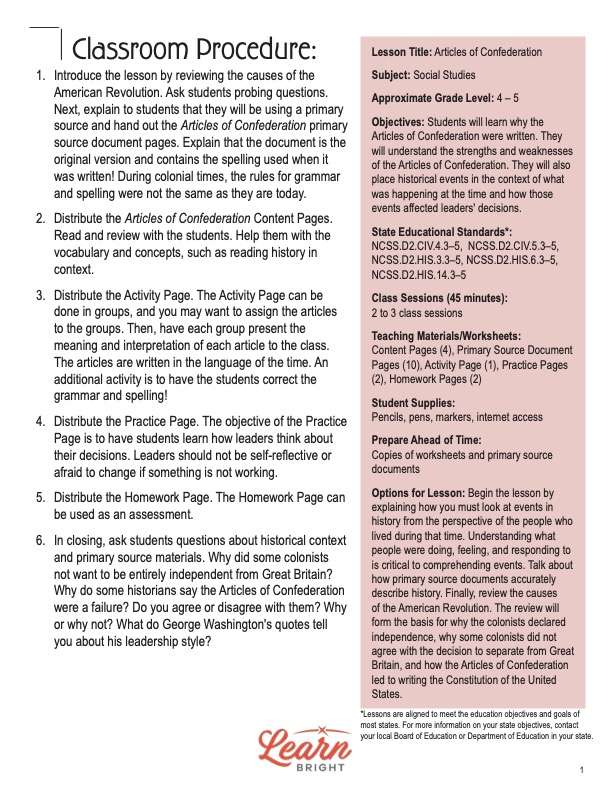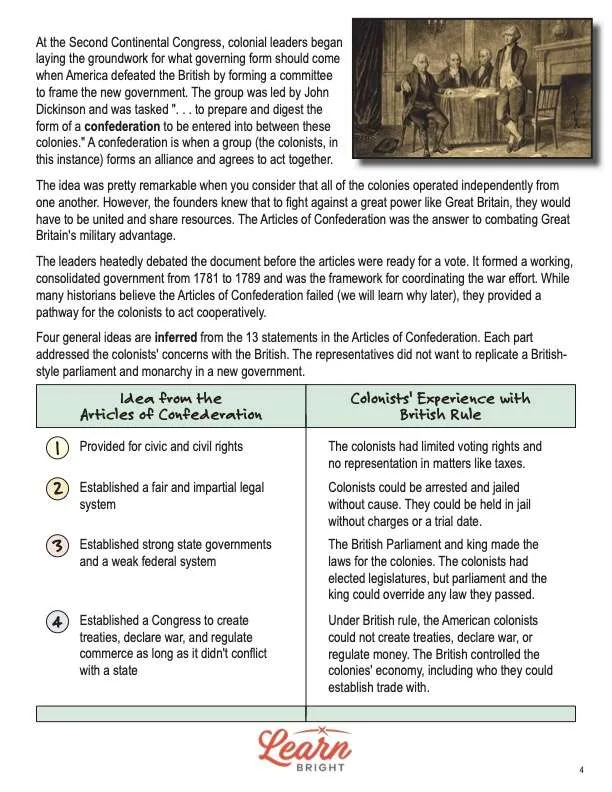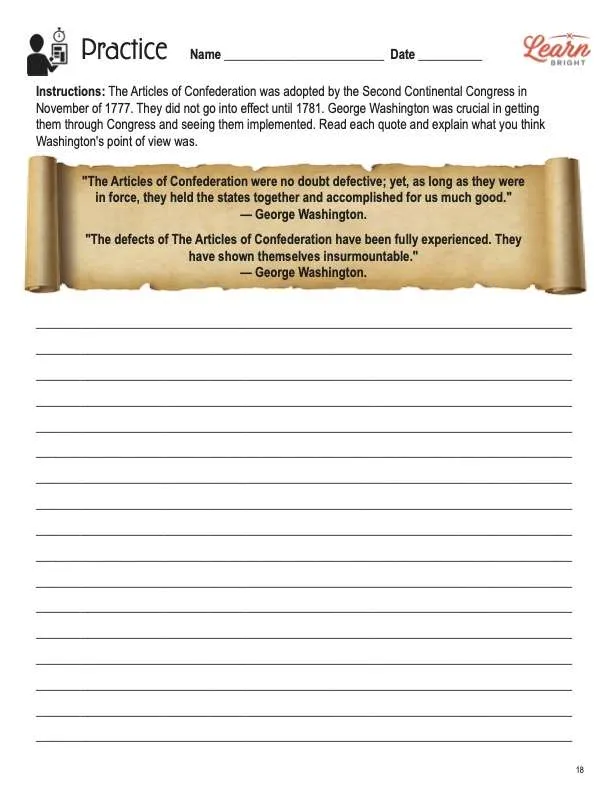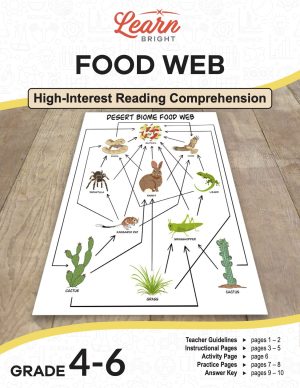Description
What our Articles of Confederation lesson plan includes
Lesson Objectives and Overview: Articles of Confederation identifies the Articles of Confederation and outlines some of its strengths and weaknesses. Students will learn why the Articles of Confederation were written. They will also place historical events in the context of what was happening at the time and how those events affected leaders’ decisions. This lesson is for students in 4th grade, 5th grade, and 6th grade.
Classroom Procedure
Every lesson plan provides you with a classroom procedure page that outlines a step-by-step guide to follow. You do not have to follow the guide exactly. The guide helps you organize the lesson and details when to hand out worksheets. It also lists information in the yellow box that you might find useful. You will find the lesson objectives, state standards, and number of class sessions the lesson should take to complete in this area. In addition, it describes the supplies you will need as well as what and how you need to prepare beforehand. Ensure your students have internet access.
Options for Lesson
The lesson includes an “Options for Lesson” section that lists a number of suggestions for activities to add to the lesson or substitutions for the ones already in the lesson. Begin the lesson by explaining how you must look at events in history from the perspective of the people who lived during that time. Understanding what people were doing, feeling, and responding to is critical to comprehending events. Talk about how primary source documents accurately describe history. Finally, review the causes of the American Revolution. The review will form the basis for why the colonists declared independence, why some colonists did not agree with the decision to separate from Great Britain, and how the Articles of Confederation led to writing the Constitution of the United States.
Teacher Notes
The teacher notes page includes a paragraph with additional guidelines and things to think about as you begin to plan your lesson. This page also includes lines that you can use to add your own notes as you’re preparing for this lesson.
ARTICLES OF CONFEDERATION LESSON PLAN CONTENT PAGES
Historical Context
The Articles of Confederation lesson plan includes four pages of content. To understand the Articles of Confederation, we first need to get historical context, or an understanding of what happened in the American colonies before the articles were introduced. Let’s set the stage!
The American colonists were disenchanted with the British governance of the colonies. You probably know most of the story and why. Although most of the
colonists were somehow connected to Great Britain, parliament and the king were putting in place taxes, fees, and regulations that many colonists thought unfair. The colonists had no say in authorizing or deciding how the money collected was to be used. The king and parliament didn’t consider the Americans as British citizens; after all, they didn’t live in Great Britain. Americans had no say in how they were governed.
You know the rest of the story. After numerous attempts to negotiate a peaceful resolution to the demands of Great Britain failed, the Americans declared their independence (Declaration of Independence, July 4, 1776). Doing so resulted in a war—the American Revolution. Even though an American victory was not assured until the 1780s, the Second Continental Congress attendees thought it prudent to consider what type of government they wanted to live under. What would work for the independent-minded Americans based on their experience with the British Parliament and king?
Developing the Confederation
At the Second Continental Congress, colonial leaders began laying the groundwork for what governing form should come when America defeated the British by forming a committee to frame the new government. The group was led by John Dickinson and was tasked “. . . to prepare and digest the form of a confederation to be entered into between these colonies.” A confederation is when a group (the colonists, in this instance) forms an alliance and agrees to act together.
The idea was pretty remarkable when you consider that all of the colonies operated independently from one another. However, the founders knew that to fight against a great power like Great Britain, they would have to be united and share resources. The Articles of Confederation was the answer to combating Great Britain’s military advantage.
The leaders heatedly debated the document before the articles were ready for a vote. It formed a working, consolidated government from 1781 to 1789 and was the framework for coordinating the war effort. While many historians believe the Articles of Confederation failed (we will learn why later), they provided a pathway for the colonists to act cooperatively.
Four general ideas are inferred from the 13 statements in the Articles of Confederation. Each part addressed the colonists’ concerns with the British. The representatives did not want to replicate a British-style parliament and monarchy in a new government. The lesson lists the ideas and describes the colonists’ experience with British rule that led to each idea.
No Monarchy, No Parliament
Their experience with the British very much guided the authors of the Articles of Confederation. Because they did not want to repeat their experience, they intentionally wrote the document so that a strong federal government could not supersede states in the future. They didn’t want to create an elected monarchy. They ensured that the Congress could not interfere in the lives of citizens as the parliament, king, and British military had done with the colonists. Sometimes, in history, people overreact to their experiences. Then to correct an error, they often overcorrect.
This may have been the case with the Articles of Confederation. Understandably, the representatives did not want to recreate an American monarchy. Their experience with a monarch convinced them that a strong centralized government with unlimited and unchecked power restricted freedom. Creating strong state legislatures and a weak federal Congress looked like a good solution. While it seemed a good idea at the time, it later proved to be the undoing of the Articles of Confederation. Why? To understand why, we look no further than George Washington.
Problems with the Articles
The Articles of Confederation was ratified in 1781. Just three short years after the ratification of the document, Washington and others began to express concerns over the weak federal system. On January 18, 1784, Washington wrote to Virginia governor Benjamin Harrison that the government was “a half-starved, limping Government, that appears to be always moving upon crutches, and tottering at every step.” Many of the problems were financial. In 1784, there was no federal income tax. The government relied on the states to collect dues, fees, and tariffs. When Congress asked for the money from the states, the states would only send part of it or none at all!
No doubt Washington recalled his experience with Congress during the war. Congress adjourned many times without approving funds to pay soldiers—not to mention, they had no way to collect the money they needed to sustain the war effort. At Valley Forge (a critical turning point in the war), Washington paid soldiers from his personal wealth. A better example has to do with the money collected to pay war debts. The colonists borrowed money to pay for the war.
Between 1781 and 1787, Congress asked for 10 million dollars. The states only paid about 1.5 million. It was insufficient to pay for government services and the debt from the war. The states who united during the war quickly became competitors after the war ended.
Did the Articles Work?
The lesson lists some of the weaknesses of the Articles of Confederation. It’s easy to see why Washington and others doubted the government could survive under these rules. And it’s no wonder many historians call the Articles of Confederation a failure. However, we must return to the context in which the founders were operating before we can agree with the historians who claim the document was a failure.
The war for America’s independence raged on and on. In the early years, colonists were far from being unified in their support of the war. Many thought they should remain part of Great Britain and negotiate rather than fight. Keep in mind that the majority of colonists migrated from Great Britain. Most had relatives who still lived there. Beyond familial ties, economic interests were strong, even during the war.
Was the Articles of Confederation a failure, as many historians believe? As you have learned, the answer is complicated. On one hand, it failed to create a working centralized government when it was most needed. The Articles of Confederation allowed the states to have their own currency system, negotiate with foreign powers, and maintain state militias or armies. There was only one branch of government and no way to fund it, and every vote by Congress required approval from 9 of 13 states to pass.
On the other hand, it provided a framework for a stronger Constitution in the future. American leaders learned what worked and what didn’t. The Articles of Confederation gave the colonists hope to self-govern despite its problems. It was the first written constitution for America. Like many new things we try, we learn from our failures, increasing our chance of success. So, success or failure? You decide!
ARTICLES OF CONFEDERATION LESSON PLAN WORKSHEETS
The Articles of Confederation lesson plan includes three worksheets: an activity worksheet, a practice worksheet, and a homework assignment. Each one will help students solidify their understanding of lesson material. You can refer to the guide on the classroom procedure page to determine when to hand out the worksheets throughout the lesson.
MODERN TRANSLATION ACTIVITY WORKSHEET
The activity requires students to put their critical thinking skills to the test. They will first choose one of the articles from the Articles of Confederation. Then they will rewrite it using modern language and explain what the article means. There are three boxes on the worksheet for them to use. If they need more room to write, they can use the back of the worksheet or another sheet of paper.
GEORGE WASHINGTON’S THOUGHTS PRACTICE WORKSHEET
For the practice worksheet, students will read two quotes from George Washington regarding the Articles of Confederation. They must analyze the quotes and explain in their own words what they believe George Washington felt about the document. What was his point of view toward the Articles of Confederation? Was he in favor of or against it?
ARTICLES OF CONFEDERATION REVIEW HOMEWORK ASSIGNMENT
Students will review what they learned by answering five questions based on what they read in the content pages. If students need more room to write their responses, they can use extra paper or the back of the worksheet.
Worksheet Answer Keys
This lesson plan includes answer keys for the practice and homework worksheets. Correct answers are in red, but given the nature of the assignments, students’ responses will vary. For the most part, however, the general ideas should match those of the answer keys. If you choose to administer the lesson pages to your students via PDF, you will need to save a new file that omits these pages. Otherwise, you can simply print out the applicable pages and keep these as reference for yourself when grading assignments.









